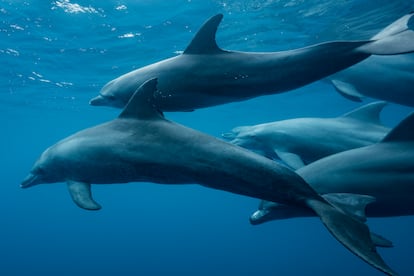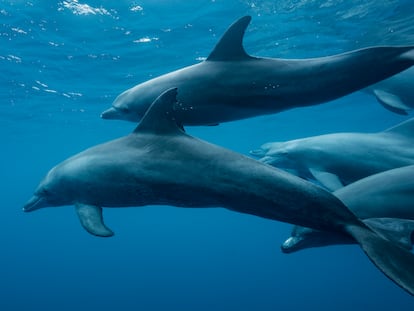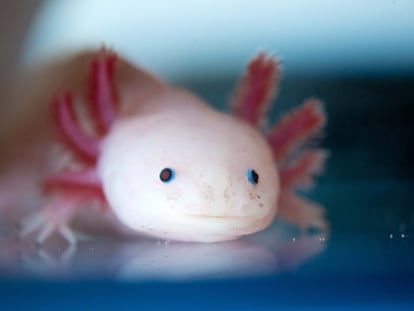Dolphins: An unexpected ability to forge alliances and avoid conflict
Several studies show that these marine mammals can harmoniously join unfamiliar pods and make up to 50 new ‘friends’

Many mammals and birds have hostile reactions when they come into contact with groups outside their own communities. But not every species. Bonobos, sometimes known as the pygmy chimpanzee, are one of the closest living relatives of humans and are quite tolerant of between-group interaction. But land mammals are not the only outliers. A study recently published in Royal Society Open Science identified a partial merger of two populations of Atlantic spotted dolphins (Stenella frontalis). Part of a dolphin community migrated 100 miles (160 kilometers) south to merge with another population. The migrants included dolphins of all ages and of both sexes. Affiliative interactions between the dolphins indicated that they were forming social relationships.
One of the study authors, Nicole Danaher-García, a biologist and member of the Dolphin Communication Project (DCP), notes that once the dolphins migrated and joined the other community, they stayed there. “It’s almost unheard of for this to happen in land mammals. Even when groups of bonobos spend weeks or months together, they often separate again. These dolphins are still together, so they seem to be tolerant of strangers.” While DNA testing is still needed as proof, the males from one group seemed to have mated with females from the other and produced calves.
The study had an unexpected beginning. The Dolphin Communication Project (DCP) began studying a dolphin population of about 120 near the island of Bimini in The Bahamas in 2001. For the next 11 years, they did not observe any new adults, except for the younger dolphins that matured to adulthood. But in 2013, DCP suddenly observed an influx of new male and female adults of varying ages, and began tracking them. During the first year, they observed dolphins from the Bimini area mingling with others from another community.
“The following year we saw them much more frequently,” said Danaher-García, “and we were able to confirm that they were from an area called White Sand Ridge in the northern Bahamas.” The original social structures were well established and, although a disruption of relationships might be expected, both communities merged easily and even formed strong, new bonds. The White Sand Ridge dolphin population has been studied for about 30 years, and in 2012 numbered 85 individuals.
Nearly 50 dolphins from White Sand Ridge were sighted in Bimini during the five years after the first migration. DCP continued to observe northern dolphins until 2019, but was forced to stop their monitoring during the pandemic. Danaher-García says that some people have reported seeing individuals from both groups since then. “Maybe some went back north, but there is a large group that stayed,” she said.
The DCP study is not alone in demonstrating the sociability of dolphins and potential similarities with human sociability. A recent study published in PNAS shows that like humans, dolphins are capable of forming alliances between unrelated individuals. The study analyzed 121 male Indo-Pacific bottlenose dolphins (Tursiops aduncus) in Shark Bay (Australia) between 2001 and 2006, and found that both dolphins and people form strategic intergroup alliances between unrelated individuals. The average number of adult male dolphins with which each male directly associated was 22. Some associated with as many as 50 males. Furthermore, the duration with which males join with females depends on being well-connected with third-order allies, i.e., other groups. Thus, alliances between groups provide greater access to contested resources, thereby increasing reproductive capacity.
Scientists have identified about 40 different species of dolphins. There is a great deal of variety among dolphin species, and very little is known about some of them. There are also behavioral differences among dolphins of the same species. María Victoria Hernández Lloreda (Department of Psychobiology and Methodology in Behavioral Sciences at the Complutense University of Madrid) says that diverse social behavior may be attributed to the specific circumstances of each community. “The same groups can be tolerant of some and aggressive toward others. It depends on their specific pressures, such as their social and economic [available resources] situations.” A 2017 study published in Nature Ecology and Evolution concluded that cetacean (whales and dolphins) social cognition may have arisen to provide the capacity to learn and use a diverse set of behavioral strategies in response to the challenges of social living.
“The fact that they are more tolerant could also indicate that they also have a greater flexibility and capacity for social cognition,” said Hernández Lloreda. These social cognition abilities enable dolphins to adopt the behavior of others by “learning from the group,” she said. “It’s not a predetermined behavior. You behave differently based on what you learn and on your social environment.”
José Zamorano-Abramson (Center for Social Complexity Research at the Universidad del Desarrollo in Santiago, Chile) asks, “How does one learn? How is it that the same species behaves differently? Maybe it’s because this group has a tradition, a way of behaving. We can say that these groups demonstrate cultural traditions. Some behavioral differences can be explained by what was learned socially from family or group members, and others by what was learned in their community.”
Tu suscripción se está usando en otro dispositivo
¿Quieres añadir otro usuario a tu suscripción?
Si continúas leyendo en este dispositivo, no se podrá leer en el otro.
FlechaTu suscripción se está usando en otro dispositivo y solo puedes acceder a EL PAÍS desde un dispositivo a la vez.
Si quieres compartir tu cuenta, cambia tu suscripción a la modalidad Premium, así podrás añadir otro usuario. Cada uno accederá con su propia cuenta de email, lo que os permitirá personalizar vuestra experiencia en EL PAÍS.
¿Tienes una suscripción de empresa? Accede aquí para contratar más cuentas.
En el caso de no saber quién está usando tu cuenta, te recomendamos cambiar tu contraseña aquí.
Si decides continuar compartiendo tu cuenta, este mensaje se mostrará en tu dispositivo y en el de la otra persona que está usando tu cuenta de forma indefinida, afectando a tu experiencia de lectura. Puedes consultar aquí los términos y condiciones de la suscripción digital.
More information
Últimas noticias
Aquilino Gonell, former Capitol sergeant: ‘If it hadn’t been for the police, the US would be a dictatorship’
A hybrid building: Soccer pitch, housing, and a shopping mall
Europe urges Trump to respect Greenland following annexation threats
Science seeks keys to human longevity in the genetic mixing of Brazilian supercentenarians
Most viewed
- Alain Aspect, Nobel laureate in physics: ‘Einstein was so smart that he would have had to recognize quantum entanglement’
- Mexico’s missing people crisis casts a shadow over World Cup venue
- Why oil has been at the center of Venezuela-US conflicts for decades
- Trump clarifies who is ultimately in charge in Venezuela: ‘Me’
- Mexico seeks to shore up its defenses following US incursion in Venezuela











































